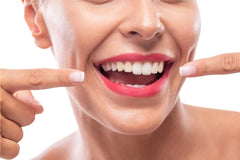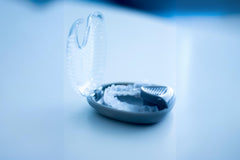With the help of clear aligner treatment, many people's dreams of having a straighter smile come true. These practically undetectable trays provide a discrete and comfy replacement for conventional braces. However, what occurs when the first course of treatment is almost finished but there is still some potential for improvement? Overcorrection aligners are a calculated step toward enduring results.
Table of contents
-
Overcorrection Aligners: Are They The Same as Clear Aligners?
-
Understanding Clear Aligners: The Basis of Refinement
-
What are Overcorrection Aligners?
-
How Do Overcorrection Aligners Work?
-
Benefits of Overcorrection Aligner
-
Decreased Relapse Risk
-
Perfecting Your Smile
-
Increased Confidence
-
Potentially Shorter Treatment Time
-
Are Overcorrection Aligners Effective?
-
Are Overcorrection Aligners Necessary?
-
What to Expect from the Overcorrection Aligner Refinement Process
-
FAQs
Understanding Clear Aligners: The Basis of Refinement
Clear aligners consist of a set of recyclable, custom-made trays that are intended to move your teeth into the appropriate positions over time. They function by gradually forcing your teeth to shift by gently and consistently exerting pressure. With each transition, the aligners in the series move your teeth a little bit closer to their ultimate alignment.
What are Overcorrection Aligners?
Refinement aligners, another name for overcorrection aligners, are used to move some of your teeth into a position that is slightly out of alignment. To make up for the lag in tooth movement, the aligner's built-in overcorrection mechanism causes the teeth to travel past the appropriate end position. The tooth can be moved to the intended ultimate position with the use of overcorrection.
How Do Overcorrection Aligners Work?
Aligner treatments are increasingly using refinement or overcorrection aligners. Depending on your dental needs, clear plastic aligners are a great treatment choice for a variety of tooth misalignments, while certain treatments may take longer or require more trays.
Overcorrection aligners may be recommended by an orthodontist or dentist for certain individuals. Occasionally, they might provide these treatments with your last set of trays and inform you that you are under no obligation to wear them. To maintain excellent alignment for a longer period, overcorrection aligners might be provided.
Benefits of Overcorrection Aligner
Overcorrection aligners are not necessary for everyone, but for those who want a genuinely solid and long-lasting smile, they have several benefits:
Decreased Relapse Risk
The main advantage is that there will be less likelihood of teeth shifting again after treatment. You will be able to enjoy your straighter smile for many years to come as a result of this.
Perfecting Your Smile
Overcorrection makes the last adjustments possible, guaranteeing that your teeth are positioned precisely and that your bite is balanced.
Increased Confidence
You can feel more at ease and confident in all social situations if you have a consistent grin.
Potentially Shorter Treatment Time
Overcorrection aligners may be able to avoid the need for further first treatment cycles in some situations, which could save you time.
Are Overcorrection Aligners Effective?
It is recommended that you mention any potential need for overcorrection with your orthodontist at your session. It's important to wear the corrective aligners that were provided all the way through since they stabilize the teeth that need to be refined and support long-term stability for the smile you desire. The majority of teeth respond favorably to this kind of care.
Are Overcorrection Aligners Necessary?
You might not be able to avoid overcorrection treatment if you have moderate to severe dental misalignment, which could prolong your orthodontic treatment by several weeks. It's crucial to stick to the treatment plan your orthodontist or dentist prescribed if you wish to lessen the need for overcorrection trays.
This means spending roughly 22 hours a day wearing each pair of your regular aligners for the standard two-week period. While wearing them inconsistently will prevent your teeth from shifting as intended with normal treatment, forgetting to wear them for the full 22 hours once in a while is unlikely to adversely affect your alignment.
What to Expect from the Overcorrection Aligner Refinement Process
The following phases are usually involved in the refinement process when using overcorrection aligners:
Consultation
Every patient's situation is unique, your orthodontist will do an initial examination. They will determine whether or not you are a good candidate for overcorrection aligners by carefully evaluating your dental needs. They will give you a thorough explanation of the treatment and how it will operate if they are taken into consideration.
Dental Impressions
To manufacture the last set of overcorrection aligners, new dental impressions or scans may be required.
Wearing Schedule
When your overcorrection aligners arrive, your orthodontist will provide you with instructions on how long to wear them. It will be advised that you adhere to the prescription to get the best outcomes possible. Patients who don't adhere to the wearing time may find that their treatments take longer and have an overall negative effect on their health.
Tracking Results
Your orthodontist will monitor your progress to guarantee the stability and efficacy of the aligners used for overcorrection. Your orthodontist can determine whether therapy is going well by keeping an eye on the progress and identifying any underlying problems.
Clear aligners and overcorrection aligners are two different devices that function in harmony. Overcorrection aligners refine your smile for long-lasting effects, while clear aligners straighten it. They guarantee that your smile remains flawless by taking aggressive measures to address any possible relapse. If you want a confident smile that lasts, talk to your dentist or orthodontist about overcorrection.
FAQs
1. What distinguishes them from conventional clear aligners?
To account for the possibility of relapse or gradual tooth settling, overcorrection aligners are made to slightly overcorrect teeth positions beyond the intended outcome.
2. Are aligners for overcorrection appropriate for all people?
A person with mild to moderate dental misalignments who is dedicated to using the aligners as prescribed by their orthodontist may find that overcorrection aligners are a good fit.





















